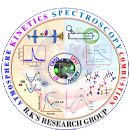The thermal decomposition of 2-fluoroethanol (FEOH) has been studied in the temperature range of 1000−1200 K behind reflected shock waves in a single pulse shock tube. The total pressures behind the reflected shocks varied between 13 and 23 atm. The products observed in the covered temperature range are CH3CHO, C2H3F, CH4, CO, C2H4, and C2H6. The unimolecular eliminations of HF and H2O are found to be the major channels through which 2-fluoroethanol decomposes under these conditions. The rate constant for HF elimination is found to be 1013.17±0.33 exp[−(59.5 ± 1.7)/(RT)] s-1, and the rate constant for H2O elimination is found to be 1014.30±0.34 exp[−(69.7 ± 1.7)/(RT)] s-1, where the activation energies are given in kcal mol-1. The CH3CHO produced by HF elimination through the vinyl alcohol intermediate is chemically active and decomposes leading to CH4 and CH3CH3 products. The production of ethylene could not be explained from the CH3CHO pyrolysis mechanism. It is most likely formed directly from the reactant through HOF elimination or by radical processes beginning with C−O bond dissociation. Ab initio (Hartree−Fock [HF] and second-order Møller−Plesset perturbation theory [MP2]) and density functional theory [DFT] calculations have been carried out to find the transition state and activation barrier for HF and H2O elimination reactions. The HF calculations overestimate the barrier by 18 kcal mol-1 for HF elimination and 22 kcal mol-1 for H2O elimination, and including electron correlation improves the agreement. In particular, DFT predictions for activation energies for HF and H2O elimination reactions are within 1 kcal mol-1 of the experimental values.
-
Call
-
E-mail
Journal Details
1. Thermal decomposition of 2-fluoroethanol: A Shock Tube and ab initio study..
B. Rajakumar, K. P. J. Reddy, E. Arunan. J J. Phys. Chem, , 9782–9793, 107
